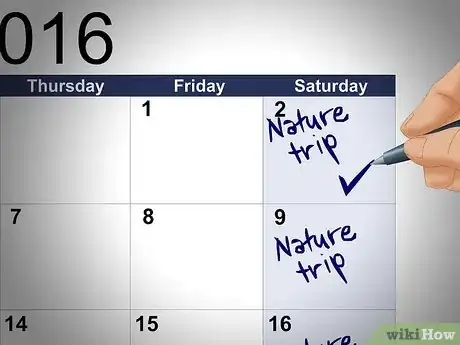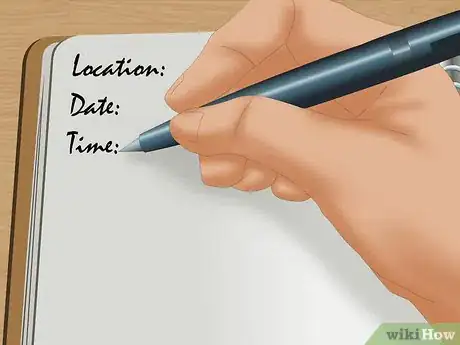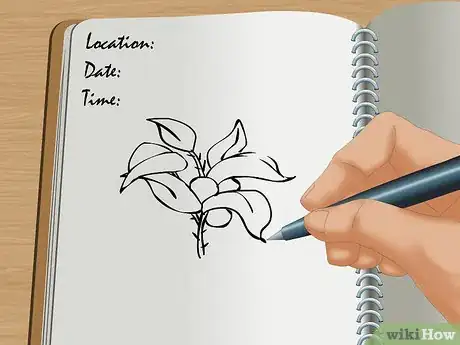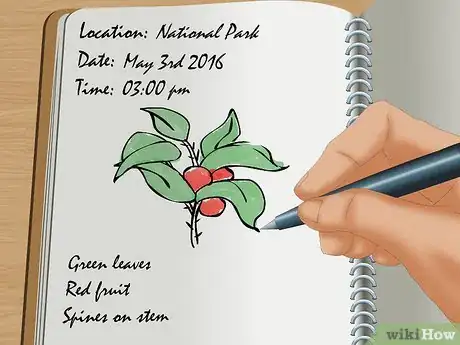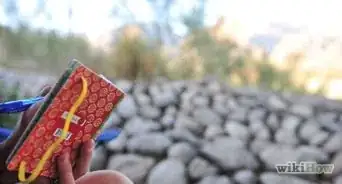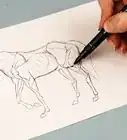wikiHow is a “wiki,” similar to Wikipedia, which means that many of our articles are co-written by multiple authors. To create this article, 27 people, some anonymous, worked to edit and improve it over time.
This article has been viewed 144,900 times.
Learn more...
"Most people are on the world, not in it; have no conscious sympathy or relationship to anything about them," wrote John Muir, the environmentalist, scientist, adventurer and Sierra Club founder. Unfortunately, his statement is far truer now than it was in his time. In today's society, how can we connect with our environment? How can we increase our appreciation for nature? One response is for us to follow Muir's example – and that of John James Audubon and other notable writers and artists – and keep a nature journal.
Like a personal journal or diary, a nature journal is a place to record our observations and to reflect on them, but unlike a diary, a nature journal is used specifically to record our observations of, and thoughts on, nature. Take up nature journaling and you can end up learning more about nature and about yourself.
Steps
-
1Decide what kind of nature journal you'd like to make. You can also use a nature journal in many cool, different ways depending on your own preferences and all the nature that is around you. And it's a good idea to think a little bit about what kind of journal you want to make, so that you can get an appropriately-sized book along with all the materials you'll need. Some ideas of how to approach your own nature journal include:
- Simply record all your excursions into nature. Write down what you see, feel and notice; add photos as well if wished.
- Create a nature journal that just focuses on a certain place (such as a river, a park, a secret bush hideout your backyard) or on living beings (such as redwood trees, monkeys, cockroaches).
- Create a nature journal to chronicle a particular trip.
- There are also several types of journals that are generally used for more specific scientific purposes, such as Grinnell journals and phenology journals (see the "Tips" section below).
-
2Make or buy a suitable journal of you choice. The majority of nature journals are compiled using pads or books of plain white paper. Lined paper generally interferes with sketching, but it may be suitable for your purposes and it is possible to find some books with a division on each page that includes both plain paper and lined paper. Or, you can put loose sheets in a binder or buy a pad (or specially-made journal) that's already bound. Since you'll be taking your journal into the elements, you'll want to make sure it's sturdy and protected. While some paper is waterproofed, most will need to be protected by a book cover or a plastic bag.
- If you can afford it, choose strong, high-quality paper. Even if you can't invest in good paper, ensure that the pages are well secured, either in good book binding or spiral binding.
- Look for a journal book that has an interesting and high quality cover, or make your own cover to protect your journal's contents.
- Consider any special needs. Perhaps any old pad will do for your purposes, but think it through.
- If you want to make very large drawings, for example, make sure you have a big enough journal, but if backpack space is at a premium, go with a smaller one.
- If you want to include watercolor paintings, get appropriate paper, and if you're going to paste photos or souvenirs in your journal, consider getting archival paper.
- If you're going someplace very wet, perhaps you'd best go with a waterproof pad.
Advertisement -
3Get any other equipment you'll need. You don't need a lot of equipment to keep a nature journal. A journal and a pencil will do just fine if you simply want to write in your journal and make sketches. If you want to do more colorful drawings, get crayons or colored pencils or maybe even a watercolor set. If you want to paste photos or found objects into your journal, get some appropriate adhesive or photo tabs. If you've got a lot of equipment, you may want a special case or binder to keep it all together. Again, just think about your needs and your budget and customize your journaling set.
-
4Dedicate time to journaling. Finding time to keep a journal or diary of any kind can be difficult, and nature journals are no different. Depending on the plan for your journal, though, you can be flexible. Perhaps you just want to go out one day on the weekends, or perhaps you just want to keep your journal while on a camping trip. If you're doing fieldwork, of course, you'll probably need to make an entry in your journal at least once a day. Whatever you do, make sure you actually use your journal.[1]
- Keep your journal somewhere that is easy to access. This will encourage you to use it more often, especially if it's somewhere easily noticed.
-
5Observe the world around you. Creating a nature journal is much less about writing and drawing than it is about observing. No matter where you live, you can observe nature in some form. Get out and watch. Sit silently or take a leisurely stroll, and contemplate your environment or your chosen subject. Don't worry about writing or drawing right away; just pay attention.[2]
-
6Do your writing on location. A nature journal is most valuable if you use it in the field to record your observations as you are observing them. If you rely on your memory to write in your journal later, chances are your journal will be less accurate and you might not be as encouraged to concentrate on your environment in the field.
- Add your nature journal to any lists of things to take for hikes, camping trips, vacations, etc. That way, you're less likely to forget to take it with you to new locations.
-
7Begin each entry with the location, date, and time. Like any journal, you'll want to be able to look back at your nature journal and know exactly when and where you were when you wrote each entry. If your journal is for scientific purposes, you'll need to be very specific, and you may need to include other basic information, such as weather specifics.
-
8Record your observations with drawings or paintings. A lot of people consider themselves bad artists, and you may be one of them. No matter what your current artistic ability, you should at least try to do some sketches of plants, animals, or scenes that you observe. For one thing, drawing (or attempting to draw) an accurate rendition of something helps you to focus on that thing more deeply than you would otherwise. Draw a plant, for example, and you're naturally forced to pay attention to the shapes of the leaves, the differences between each leaf, the many different colors, and other details that you might otherwise miss. Thus, it's not particularly important to draw well – drawing simply helps you observe better. Of course, if you're recording your observations for scientific research or to help you identify a plant when you get home, the quality of the drawing does count. Fortunately, your drawings will get better with time and practice, so don't give up.[3]
- Take pictures. If you just can't bring yourself to draw, photograph your subject. Even if you're a great artist, you may want to add photographs to your journal from time to time. Photographs can be useful, creative, and sometimes absolutely necessary, but be sure to at least try doing some drawing, too. If you're going to take pictures, be sure to leave some space in your journal to paste them in later.
-
9Write about what you observe. What and how you write should be customized to the purpose of your journal, but for a general-purpose nature journal, you can write just about anything.
- Be descriptive. Try to ignore what you know about things you see, and write about them as though you're seeing them for the first time. Be as descriptive as possible so that another person could pick up your journal 100 years from now and be able to picture the bird you wrote about and learn about it even if that bird no longer exists. While this may seem silly, keep in mind that antique nature journals have provided us with much of what we know about some of the many animals that became extinct in the past two centuries. You may wish to go into great detail about one particular plant, or you may wish to write only about the characteristics of the entire environment. Try to get the basics down, such as the weather and environment you're in, and then write about whatever interests you.
- Write how you feel. If you feel awestruck by a mountain or calmed by the sight of a bee on a flower, go ahead and put that in your journal. A nature journal gives you an opportunity to respond to the natural world, and writing your response can help you understand who you are – and maybe even your place in the universe.
- Don't censor yourself; don't edit as you go along. Just let your thoughts flow freely onto the paper.
- Choose your own style. You may develop a consistent style for each entry into your journal, or you may just write and sketch in whatever manner feels right at the moment. How you write and how you structure your journal are choices that you alone can make (unless you're working on a school or work assignment). Some people like to write their entries as though they're writing a letter to a friend or to themselves. Others like to include poems or little stories. Just write.
-
10Learn more about what you've seen. A journal can be a catalyst to learning. Once you've gone out and observed things in nature, go back home or visit the library and read more about what you've seen, especially if something in particular interested you or if you have unanswered questions. For example, you may see a plant you're not familiar with. Armed with your sketch and description of the plants, you can then look it up when you get back to "civilization." Use your journal to write down any questions you have – What was that bird doing when it kept moving its head up and down? Why was the grass so much shorter on one side of the hill? – and try to find the answers to these questions.[4]
- If you're keeping a journal on a specific organism or ecosystem, you'll probably find it beneficial to do as much research as you can before you go out in the field.
-
11Revisit your past entries. From time to time you may wish to consult your past journal entries for a specific reason. Perhaps you'd like to revisit a particular time in your life, or maybe you need some to compare your observations for a scientific paper. In any case, reading your nature journal can be a great learning experience, and it can be a lot of fun. You can relive days long gone by just by flipping the pages, or you can see how your attitudes and writing styles have changed over time.[5]
Community Q&A
-
QuestionI would like to learn more about sketching. What can I do?
 Community AnswerThis article will help you get started: how to sketch.
Community AnswerThis article will help you get started: how to sketch. -
QuestionHow should I decorate a nature journal?
 LAUREN OttCommunity AnswerYou can decorate it any way you want. You could put bug or plant stickers on it. You can make a sketch of a plant or animal on the cover. It is up to you!
LAUREN OttCommunity AnswerYou can decorate it any way you want. You could put bug or plant stickers on it. You can make a sketch of a plant or animal on the cover. It is up to you! -
QuestionDo I need any special paper for this journal?
 Community AnswerNot at all! You can use any type of paper. It might be a good idea to choose paper based on what you will be using your notebook for. For example, if you plan on writing a lot in your journal, your might want to use lined paper. If you plan on sketching in your notebook, you might prefer drawing paper instead.
Community AnswerNot at all! You can use any type of paper. It might be a good idea to choose paper based on what you will be using your notebook for. For example, if you plan on writing a lot in your journal, your might want to use lined paper. If you plan on sketching in your notebook, you might prefer drawing paper instead.
Warnings
- Be careful where you walk around. You could get lost. Go with a friend. You don't know what could happen when you are alone⧼thumbs_response⧽
Things You'll Need
- Journal
- Markers
- Cover for journal
References
- ↑ http://www.smithsonianeducation.org/educators/lesson_plans/journals/smithsonian_siyc_fall06.pdf
- ↑ https://vault.sierraclub.org/education/nature_journal.asp
- ↑ https://vault.sierraclub.org/education/nature_journal.asp
- ↑ https://www.plt.org/educator-tips/nature-journaling-ideas/
- ↑ http://www.smithsonianeducation.org/educators/lesson_plans/journals/smithsonian_siyc_fall06.pdf



